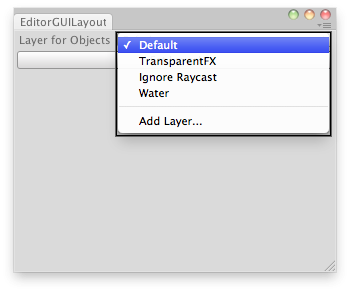static function LayerField (layer : int, params options : GUILayoutOption[]) : int
static function LayerField (layer : int, style : GUIStyle, params options : GUILayoutOption[]) : int
static function LayerField (label : String, layer : int, params options : GUILayoutOption[]) : int
static function LayerField (label : String, layer : int, style : GUIStyle, params options : GUILayoutOption[]) : int
static function LayerField (label : GUIContent, layer : int, params options : GUILayoutOption[]) : int
static function LayerField (label : GUIContent, layer : int, style : GUIStyle, params options : GUILayoutOption[]) : int
Parameters
| Name | Description |
|---|---|
| label | Optional label in front of the field. |
| layer | The layer shown in the field. |
| style | Optional GUIStyle. |
| options |
An optional list of layout options that specify extra layouting properties. Any values passed in here will override settings defined by the style. See Also: GUILayout.Width, GUILayout.Height, GUILayout.MinWidth, GUILayout.MaxWidth, GUILayout.MinHeight, GUILayout.MaxHeight, GUILayout.ExpandWidth, GUILayout.ExpandHeight |
Returns
int - The layer selected by the user.
Description
Make a layer selection field.

Set the layer of the selected GameObjects.
// Simple editor script that lets you set the layer for the selected GameObjects.
class EditorGUILayoutLayerField extends EditorWindow {
var selectedLayer : int = 0;
@MenuItem("Examples/Set Layer For Selection")
static function Init() {
var window = GetWindow(EditorGUILayoutLayerField);
window.Show();
}
//Disable menu if we dont have at least 1 gameobject selected
@MenuItem("Examples/Set Layer For Selection", true)
static function ValidateSelection() {
return Selection.activeGameObject != null;
}
function OnGUI() {
selectedLayer = EditorGUILayout.LayerField("Layer for Objects:",selectedLayer);
if(GUILayout.Button("Set Layer!"))
SetLayer();
}
function SetLayer() {
for(var go : GameObject in Selection.gameObjects)
go.layer = selectedLayer;
}
}